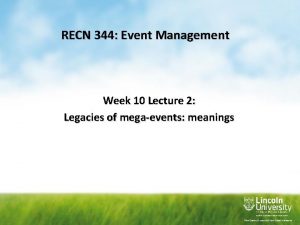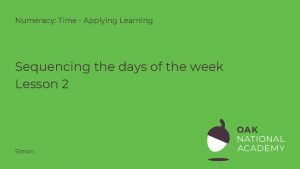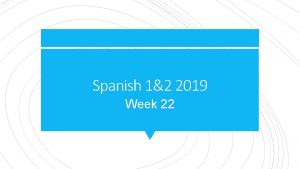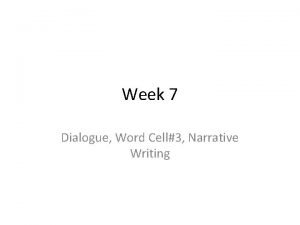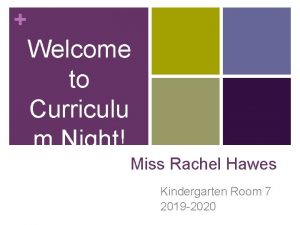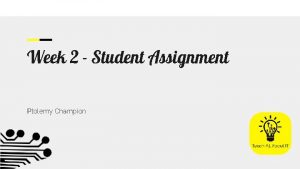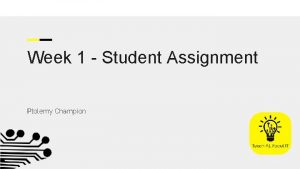Integrated Curriculu m CI 6103 WEEK 6 ASSIGNMENT













- Slides: 13

Integrated Curriculu m CI 6103 WEEK 6 ASSIGNMENT

INTEGRATED CURRICULUM Integrated Curriculum Fayth Silveus American College of Education

Subject Specific & Literacy Lesson Plan Combined

Step 2: Assess the Plan & Modify (Yes means the plan was applicable as it, an explanation tells how the plan will be modified to meet the need. ) Applicab le to Online Learning Applicab le to Visual Learners Applicabl e to Auditory Learners Applicable to Kinestheti c Learners Entrance Ticket Create using an online tool, such as Kahoot. Use vibrant colors and images. Have the words read aloud and include music. Manually answer on laptop or tablet. Video Clip with Notes Yes Yes, because they are taking notes. Allow them to doodle about the video as it plays. Teacher Asking Questions The teacher could ask questions in an online poll or Nearpod. Incorporate images as reminders about what was in the clip. Yes Create motions to go with questions and combine movements with answers. Small Groups Use breakout rooms online. Yes, transcript of video was given by teacher. Have video available to rewatch as needed. Be the notetaker and scribe, act out the answers. Summative Assessment Crete final presentation online. Yes Yes, can choose to act it out.

What is the ADDIE Framework? The ADDIE Framework is a model that is used to develop effective and fluid online courses that can evolve and change as needed. Focus is placed on the intended audience as well as the objective that must be mastered by completion of the lesson (Croxton & Chow, 2015). This Photo by Unknown Author is licensed under CC BY-SA

Step 3: Evaluate Using the ADDIE Framework Analyze the intended audience, the goals, and the resources needed to meet the objectives. Intended Audience: Third Grade Students Goal: Use critical thinking skills and collaboration to demonstrate an understanding of utilizing all four operations to solve multiple step story problems. Resources: Technology: devices for each student and internet access, video of math scenario, Kahoot, Nearpod, online polls, breakout rooms. This Photo by Unknown Author is licensed under CC BY-NC-ND

Step 3: Evaluate Using the ADDIE Framework Design the objective and the strategies for instruction and assessment. If the strategies utilized do not align with the objective, learners may tune out and begin to fall behind (Croxton & Chow, 2015). Objective: Student will be able to solve a two-step problem utilizing all four basic math operations. Strategies for Instruction: Flipped classroom approach: Send video of Math scenario ahead of live class for preview then have groups meet in breakout rooms to take notes and plan in class. Student-centered, Instructorguided instruction. This Photo by Unknown Author is licensed under CC BY-SA-NC Strategies for Assessment: Formative Assessments: Kahoot, online poll, Nearpod. Summative Assessment: Project chosen by group, presented to class via live virtual class or Flip-grid. Utilizing online games helps to engage kinesthetic learners (Mc. Glynn & Kozlowski, 2017).

Step 3: Evaluate Using the ADDIE Framework Develop resources for learning and ensure that the resources effectively guide the intended audience toward the objective. Resources: Create a zoom room with breakout sessions for group work and utilize the whiteboard and chat for student input. Utilizing Pear Deck or Google Slides, the teacher can import the desired media and materials into the lesson and allow each group to work together on given slides. Each group will have the opportunity to build their presentation and will choose how to present it to the class. This Photo by Unknown Author is licensed under CC BY-SA

Step 3: Evaluate Using the ADDIE Framework Implement the lesson and make immediate adjustments based on need. During this phase, the course is piloted, and any adjustments are made in real time (Croxton & Chow, 2015). The teacher sends the pre-class video for review, along with the expectations. Upon entering the zoom room, the teacher again goes over expectations, then opens the breakout rooms and encourages collaboration using Google slides. The groups work together, working through the questions and creating a presentation.

Step 3: Evaluate Using the ADDIE Framework Evaluate whether you have met the objectives and determine if you need to make any changes before you teach the lesson again (Croxton & Chow, 2015). The objective of the lesson was that students will be able to solve a two-step problem utilizing all four basic math operations. The lesson did not meet this objective completely. By having the summative assessment be a group activity, each student did not have the opportunity to demonstrate mastery of the objective. An individual component will need to be added as a summative exit ticket to allow demonstration of the objective by each student. This Photo by Unknown Author is licensed under CC BY-NC-ND

Step 3: Evaluate Using the ADDIE Framework STRENGTHS v. The intended audience and goal are clearly defined. v. Adding a flipped classroom and clear objective allow the lesson to be more effective. v. Using the video with note-taking allows multiple learning styles to benefit from the lesson. Giving student choice in the presentation encourages creativity and participation. WEAKNESSES v. More thought and planning must be put into the technology resources required. Setting up Zoom, having breakout rooms ready, and incorporating Kahoot, Pear Deck, and Nearpod will take forethought and time. v. The final assessment did not allow the individual students to demonstrate mastery of the objective.

Reflection Taking a subject-specific, literacy focused lesson plan and modifying it to enable the lesson to be taught effectively online is not a simple task. Determining the strengths and weaknesses of the plan by utilizing the ADDIE Framework allows the teacher to make necessary modifications in order to meet the needs of diverse learners online. Completing this evaluation process has opened my eyes to the specific areas that need addressed when preparing to teach a lesson online. Careful consideration must be given to the goals of the lesson, the objective, the resources utilized, the engagement of the student, and formative and summative assessments (Croxton & Chow, 2015). Willingness to make changes after teaching the lesson will allow for constant improvement of the lesson for future students. This Photo by Unknown Author is licensed under CC BY-SA

References
 Week by week plans for documenting children's development
Week by week plans for documenting children's development Now upon the first day of the week
Now upon the first day of the week Greek week themes
Greek week themes Gastrulation week
Gastrulation week Management week event
Management week event Nr 601 midterm test bank
Nr 601 midterm test bank Holy week objectives
Holy week objectives Hoot week
Hoot week Days of the week sequencing
Days of the week sequencing Team member of the week
Team member of the week Week 22 2019
Week 22 2019 Where were you last weekend
Where were you last weekend Week 7 dialogue
Week 7 dialogue Wednesday is my favorite day
Wednesday is my favorite day




